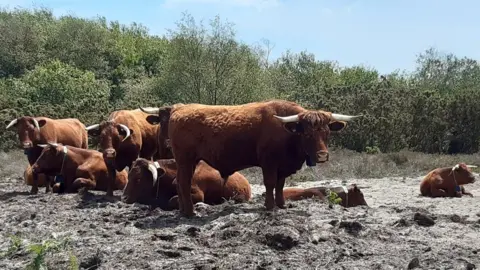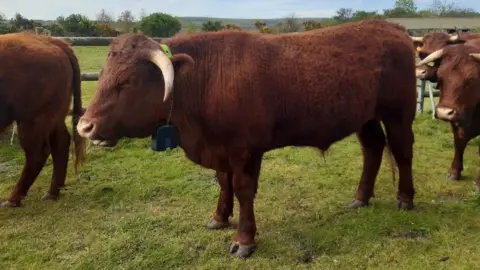Studland Bay: Cows return to restore coastal sand dunes
 Dynamic Dunescapes
Dynamic Dunescapes Cows have returned to a nature reserve in Dorset after 90 years.
National Trust livestock managers are hoping the grazing cattle will keep overgrown vegetation under control at the coastal sand dunes at Studland Bay, as well as boost biodiversity.
In the 1930s the site had more than 20% bare sand but this has since reduced to less than 2%.
The herd of 10 red Devon cattle are wearing collars with GPS trackers to help keep them in the area.
National Trust staff can use the virtual fence technology to guide the cows with sound cues to graze in specific places.
It is hoped by feeding on purple moor grass and willow, in the wet areas where vegetation is at its thickest, rare plants will be able to flourish.
The scheme is part of a project called Dynamic Dunescapes, which aims to restore 7,000 hectares (17,300 acres) of coastal sand dunes in England and Wales.
 Dynamic Dunescapes
Dynamic Dunescapes Project officer Sally Wallington said: "Studland is one of the most biodiverse landscapes in the country but, without intervention, its special habitats are gradually being lost.
"The cattle have been reintroduced to graze and to open up specific areas of the dunes, and are absolutely key to the future survival of nationally rare species.
"I'm delighted to see that over the past few weeks, they've settled in to their new home really well."
The project's aim is to raise the amount of bare sand in Studland Bay to 10%.
Julia Galbenu, Dynamic Dunescapes engagement officer at the National Trust, said people in area were "absolutely buzzing" about cows returning to the dunes.
She added: "For the team, this has been a long time coming after years of preparation and planning."
The cows are described as "calm and docile", but visitors are advised to keep a "respectful distance".

Follow BBC South on Facebook, Twitter, or Instagram. Send your story ideas to [email protected].
